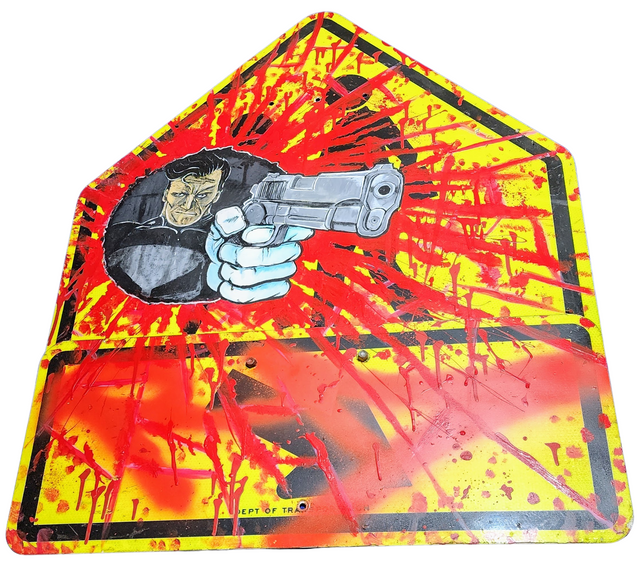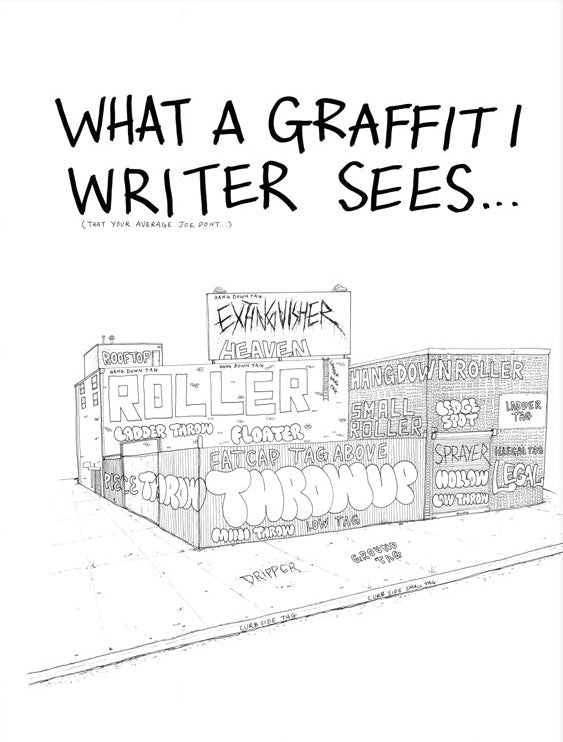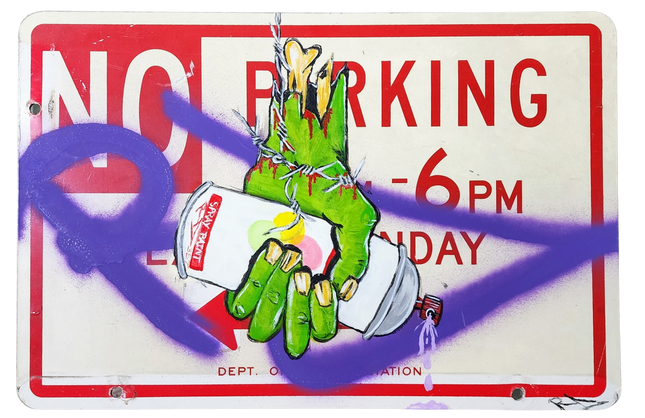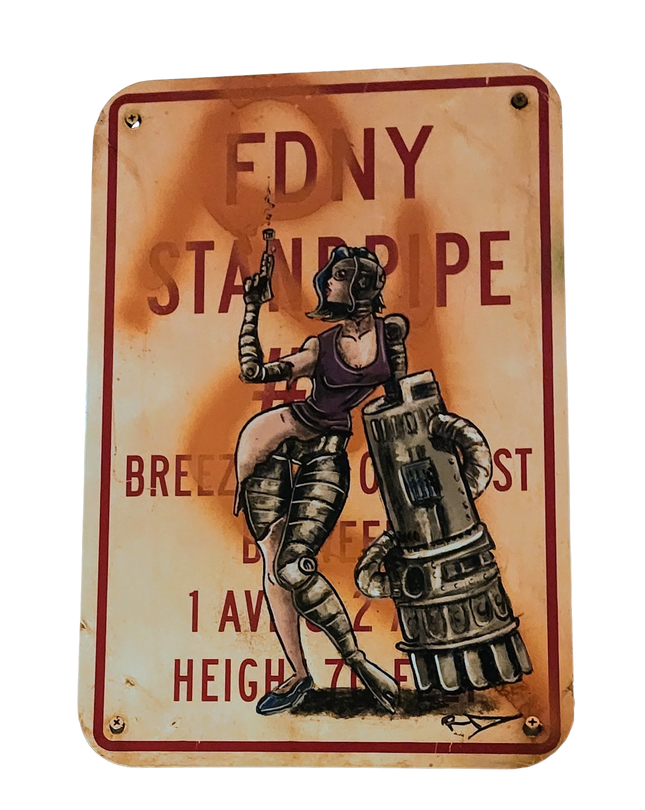
Street Signs

LushSux What A Graffiti Writer Sees Archival Print by LushSux
What A Graffiti Writer Sees Limited Edition Archival Pigment Prints on 310gsm Museum Natural Fine Art Paper by LushSux Graffiti Street Artist Modern Pop Art. Signed & Numbered Limited Edition of 40 Artwork Size 16x20 Graffiti Urban Industrial Street Scene Depicting Various Graffiti Throw Ups & Tags in Black & White. Insight into LushSux's "What A Graffiti Writer Sees" LushSux, the notorious graffiti street artist, presents a candid visualization of the urban landscape through the eyes of a graffiti writer with his work "What A Graffiti Writer Sees." This limited edition artwork, produced in a series of 40 archival pigment prints on 310gsm Museum Natural Fine Art Paper, measures 16x20 inches and is a signed and numbered offering from the artist. In black and white, the piece depicts a street scene brimming with various graffiti throw-ups and tags, capturing the raw essence of the graffiti artist's vision. Decoding the Urban Canvas in LushSux's Art The artwork is a monochromatic tribute to the graffiti culture, embodying the visual language and symbols that graffiti writers imbue in the urban environment. In this piece, buildings are not merely structures but potential canvases, bristling with opportunity and awaiting the artist's mark. LushSux translates the three-dimensional world into a flat surface yet retains the depth and complexity of the graffiti artist's perspective. Each element, from the roller tags to the dripping paint, is rendered authentically, highlighting the artist's intimate understanding of this art form. LushSux and the Graffiti Narrative Through "What A Graffiti Writer Sees," LushSux makes a poignant statement about perception and the often overlooked details in our surroundings. The piece transcends a simple depiction of graffiti; it explores the artist's psyche, the subcultural codes, and the often invisible dialogue between graffiti writers. It is a reflective piece, inviting the viewer to step into the shoes of those who see the city as a playground of expression. LushSux, as both a participant and observer in the graffiti scene, uses his artwork to bridge the street and the gallery, merging the visceral experience of street pop art with the contemplative space of fine art viewership. This artwork is not just a representation of a physical space; it is a window into the cultural and social underpinnings of the street art movement, a modern pop art phenomenon that continues to evolve and provoke.
$406.00

RD-357 Real Deal Zombie Hand Tag Original Street Sign Painting by RD-357 Real Deal
Zombie Hand Tag Original Street Sign Painting by RD-357 Real Deal Spray Paint Mixed Media One of a Kind of Artwork on New York City No Parking Notice Sign Pop Graffiti Street Art Artwork. 2014 Signed Spray Painting Original Artwork on Real NYC Reclaimed No Parking Metal Urban City Street Sign Size 18x12 of a Decapitated Zombie Hand Grasping & Spraying a Can of Krylon Spray Paint with the RD Tag in Purple. RD-357's Vivid Depiction of Urban Rebellion: The Zombie Hand Tag The 'Zombie Hand Tag' original street sign painting by RD-357, also known as Real Deal, is a provocative piece of street pop art and graffiti that embodies the rebellious spirit of urban street culture. Completed in 2014, this artwork uses a New York City 'No Parking' metal sign as its canvas, transforming a mundane object of urban regulation into a striking visual statement. The depiction of a decapitated zombie hand grasping and actively using a can of Krylon spray paint infuses the piece with a sense of post-apocalyptic creativity and survival. Interpreting the Symbolism in RD-357's Art This piece is rich with symbolism that resonates with the ethos of graffiti and street pop art. The zombie hand, often a symbol of horror and the macabre, is presented here as a vessel of artistic creation, subverting its usual connotations of death and decay. By wielding a can of Krylon, the hand breathes life into an art form that thrives on the fringes of society. The RD tag in purple spray paint marks the artist's signature and serves as an act of claiming territory, a fundamental aspect of graffiti culture. The choice of a 'No Parking' sign as the medium is deliberate and insightful. It represents the restrictions and boundaries imposed by society, which street art often aims to transgress. The act of a zombie hand, a symbol of defiance against mortality, spraying over such a sign is a metaphor for the resilience of street art. It refuses to be confined or controlled, much like the undead refusing to remain in the grave. The Aesthetics and Technique in RD-357's Zombie Hand Tag RD-357's technique in creating this piece highlights street art's raw and unapologetic beauty. The artwork, measuring 18x12 inches, showcases the artist's skill in manipulating spray paint, a medium often dismissed by the traditional art world but revered in street culture. The dripping paint from the Krylon can, the textured portrayal of the zombie flesh, and the striking contrast between the hand and the sterile sign it occupies all contribute to a composition that is as much a visual triumph as a statement piece. The use of mixed media, incorporating both the physical sign and the spray paint, reflects the layered nature of street art. It is both an object and a message, a tangible piece of the city's fabric and a commentary. The artwork challenges viewers to see beyond the surface to understand the depth and complexity of the messages conveyed through this unique artistic expression. Conclusion: The Cultural Impact of RD-357's Work The 'Zombie Hand Tag' is a potent example of how street pop art and graffiti can alter perceptions and engage with viewers on a visceral level. RD-357's work demonstrates street art's transformative power, which can turn a simple traffic sign into a thought-provoking piece that questions authority and celebrates the irrepressible nature of human creativity, even in the face of societal collapse. RD-357, whose real name and country of origin remain unknown, much like the enigmatic nature of street art itself, has created a piece that stands as a testament to the enduring spirit of street pop art and graffiti. The 'Zombie Hand Tag' is a visual spectacle and a narrative of resistance, a declaration that even in a world overrun by the metaphorical zombies of conformity and control, the artist's spirit remains unvanquished.
$600.00

RD-357 Real Deal Techno Standpipe Original Street Sign Painting by RD-357 Real Deal
Techno Standpipe Original Street Sign Painting by RD-357 Real Deal Spray Paint Mixed Media is one of the kinds of artwork on New York City FDNY Standpipe Notice Sign Pop Graffiti Street Artwork. 2014 Signed Spray Painting Original Artwork on Real Reclaimed NYC Fire Fighter Metal Urban City Street Sign Size 13x18 Futuristic Sci-Fi Cyborg Robot Woman with Guns & Future Weapon Arm Replacement—RD Tag in Rust Red. RD-357's Techno Standpipe: A Metaphor of Futurism in Street Art The original Techno Standpipe street sign painting by RD-357, also known as Real Deal, is a compelling piece of street pop art that seamlessly blends technology and urban grit. Created in 2014, this work of art reimagines a New York City Fire Department standpipe notice sign as a backdrop for a dystopian narrative. The piece, signed by RD-357, features a futuristic sci-fi cyborg woman armed with advanced weaponry, conveying powerful themes of transformation and the intersection of humanity and technology. Symbolism and Significance in RD-357's Artwork In 'Techno Standpipe,' the cyborg woman symbolizes the evolving relationship between humans and machines. Her robotic arm replacement, depicted with meticulous detail, suggests enhancement and perhaps the loss of human elements, a theme that resonates deeply in an era where technology increasingly interfaces with every aspect of life. The choice of a standpipe sign, an emblem of safety and regulation, contrasts with the unrestrained and anarchic spirit of the cyborg, creating a visual paradox that challenges the viewer to consider the implications of technological advancement. The RD tag in rust red serves as the artist's signature and integration into the piece's aesthetic, echoing the rust and decay that often accompany urban infrastructure. This artwork, measuring 13x18 inches, uses spray paint to bring to life the textures and tones of metal and flesh, bridging the gap between the industrial and the organic. RD-357's Technique and Artistic Vision RD-357's execution of 'Techno Standpipe' demonstrates a masterful use of mixed media, combining the stark, flat surface of a metal sign with the depth and dynamism of spray paint. The artist employs shading, contouring, and color contrasts to give the cyborg figure a three-dimensional appearance, projecting her out of the sign's flatness and into the viewer's space. The shadows and highlights create a sense of movement, suggesting action and energy, symbolic of street pop art's dynamic nature. The artwork's gritty realism, underscored by the wear and tear on the sign itself, reflects the urban environment's influence on RD-357. Using a real street sign repurposes the found object and contextualizes the art within the living, breathing cityscape. This piece thus becomes a conversation between the artist, the medium, and the ever-changing urban landscape. The Cultural Resonance of 'Techno Standpipe' As a piece of street pop art and graffiti, 'Techno Standpipe' carries within it the pulse of contemporary culture, where concerns about the encroachment of technology into the human sphere are ever-present. RD-357 captures this zeitgeist, presenting a future vision that is both a warning and a wonder. The artwork invites introspection on the viewer's part, urging them to contemplate the direction in which society is headed. RD-357, whose real name and country of origin remain anonymous, maintains the tradition of street artists who operate under pseudonyms, preserving the mystery and rawness central to the genre. The 'Techno Standpipe' is a bold statement within RD-357's oeuvre, a one-of-a-kind piece that embodies the transformative and provocative power of street pop art and graffiti artwork. It is a visual manifesto of the times, a metallic cry from the city's heart that resonates with modern existence's complexities.
$600.00




